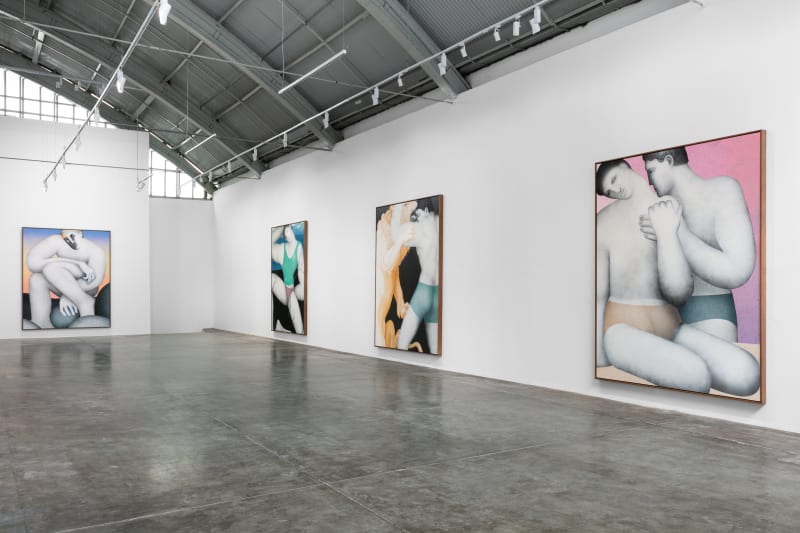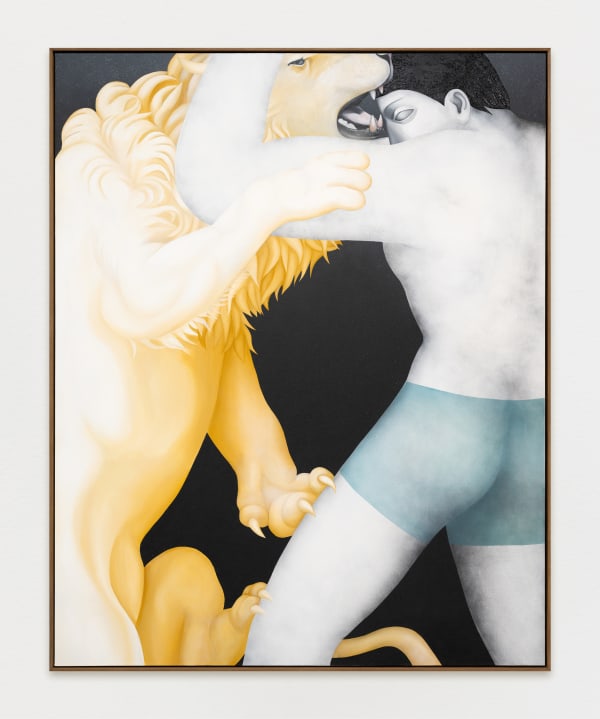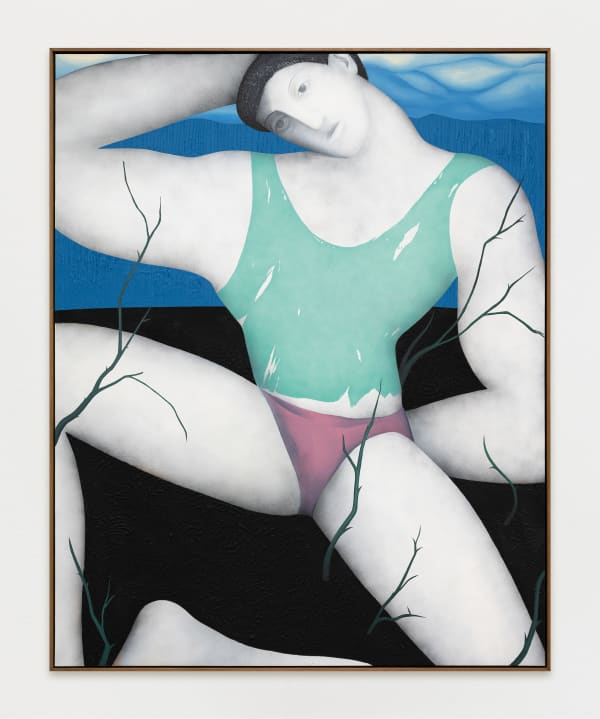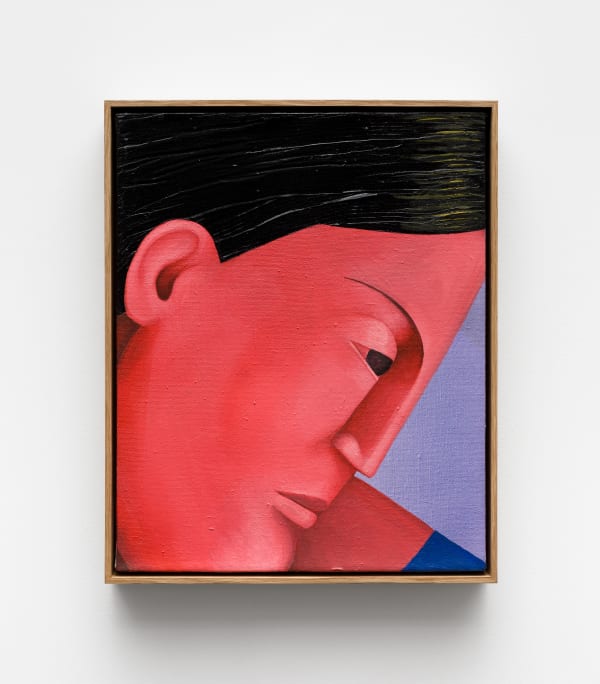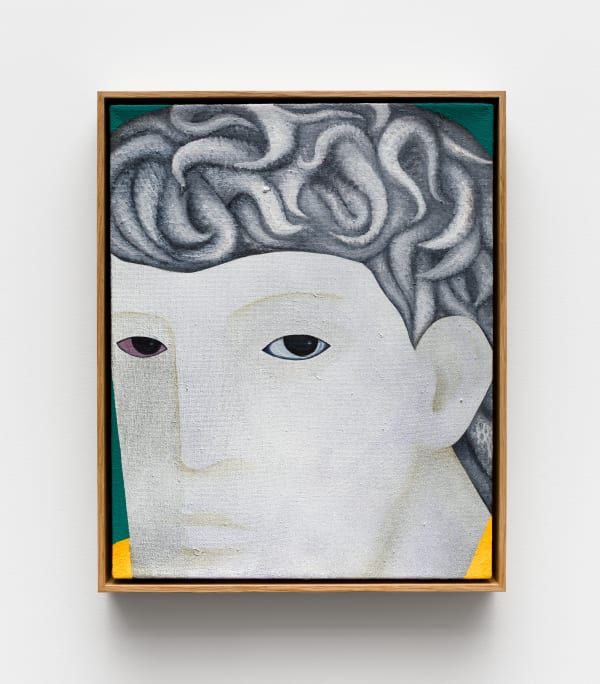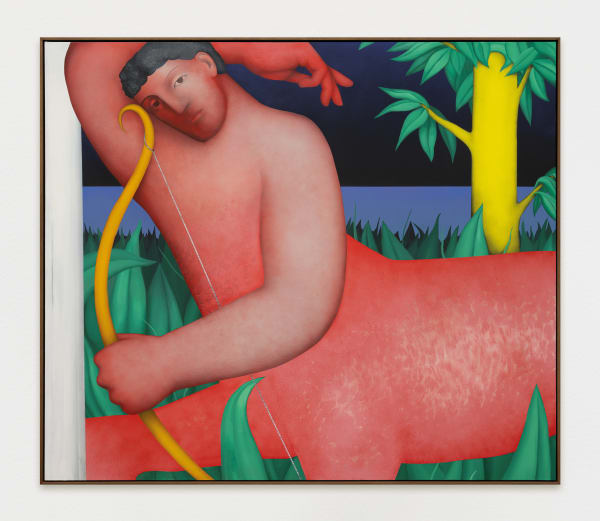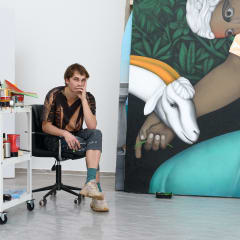Inner World Vojtěch Kovařík
Vojtěch Kovařík’s worlds. On Eyes and Eyes of the Storm
A single eye sparks from a black visage. The climate of that half-sight profile changes the acrylic brushes from wet to dry and dry to moist, according to one’s mental weather. The surface of Lost in Time (2024) is cloudily embossed. The prevailing conditions of a lonesome star in a sandy sky affect how that gaze is aligned to a destiny. And its cosmos. This small-scale portrait can foresee the calm of a storm or a spasm but can hedge its outer spaces. And it expands the viewer’s sight to the mind’s eyes.
We have already forecasted too much through visions and visuality but not much about how portrayed eyes may turn painting into forms of perturbations and temporalities. In front of the windy hairs of Lost in Time’s face, the viewer is subject to the brain and eye climatology. Paint itself appears to be the field for liquefaction of statuses. The representation of unity no longer mediates the humanity of a man but is now a mist carved into an image. And such a wet, white eye actuates melting, dissolving, and soaking surfaces that give illusions at times of tending toward a gaseousness, atomization, or, in its end, fogginess of the sand mixed with oil and acrylics. This watery syntax is at times related to how Vojtěch Kovařík densifies the canvas and how the gazes he places in his paintings become wider limits of our visibility: a repository of ancestral history and collective memory accumulated over time.
The eyes are certainly one of the essential elements, affirms the artist, and in the smaller formats of my work, it only confirms that they are dominant and decisive. In practice, I always start with the head and the gaze - it opens the curtain for me, then the story unfolds.
In the artist’s second Brazilian solo show, titled Inner World, the gaze, as an inner, indirect invitation from the viewer to the subjects and vice versa, is a form of enlightenment. It exists as a fragment of primal fragmentation and clarification. It is a three-dimensional perspective densified in space before any surface starts. Before any three-quarter profiles, even in wood-carved silhouettes (Judgement of Paris, Paris, 2024), perturb the ether. As the artist defined it, the monumental intimacy of the character breaks away from the whole while containing the lack of its containment. There are no mysteries, no tempests in these vestiges, no traces of an end or a beginning (Trapped [Narcissus and the self-love trap], 2024).
At the core of Kovařík’s practice is the symbolization of the retina into a gaze, projected there from an outside world – the tiny retinal image that the artist supposedly attempts to transcribe onto his canvas, as a blue, mythological haze (Thread of Time, 2024). Epic mirages, physiology, and neural optics have all complicated perspectival figures in which the original picture was seen to gather itself together and, along the geometrical lines of the perspective, to focus on a point behind the observer’s eye (Portrait of Ariadne, 2024). Kovařík has fed these sight waveforms into his model: an eyewitness principle. Kovařík’s eyes, which he constructs around this model, arise from the long series of interpolations between eye and brush, the rigidifying baffles of convention and method, and the distractions of conceptual, legendary weathers towards a radical reformulation of viewers’ thoughts on visuality and, consequently, our thoughts on painting. The line of thinking that passes from the subjects to the beholders remains in a conceptual enclosure, where vision is still theorized from the standpoint of a subject placed at and as the center of a world.
I perceive the gaze of my characters more as an active element, Kovařík punctualizes. It is directed not only towards the viewer but also towards themselves, towards the dynamics of their own bodies, gestures and the entire scheme of the picture. The gaze of these objects is not passive, it is a guide – it is directed somewhere, but at the same time it makes present everything that is here and now.
Although Kovařík’s practice progressively enhances that centralized subject – and the direction of its gaze is unmistakably toward a radical re-centering of the subjectivity forces (Hercules Fighting the Nemean Lion, 2024), the sighted are pictured as merely doing at a distance what the blind, as he moves his fingers over lion’s paws, are doing close to. Nevertheless, the model of the optic rays is an extension of the blind man’s struggle as a vision of an essentially tactile procedure. And through such a shaping of the gaze, though it may grasp the subject, what is fundamental to sight escapes. The crossing of perspectives in which the sighted men grasp a vantage point – tying it into a palpable climate may draw futile attempts to attain a clear mystical vision with the corporeal eye alone. What humans cannot tie into that climate is void – void as an ether, an atmosphere, a surround fulfilling the distance that positions the viewer in front of Kovařík’s painting. Here, space is modeled through the expressive weather of the eyes. It remains dissociated from the viewer, the space of a reduced stage he looks on to form his preserve in another dimension, that of the audience.
I work with a certain emptiness intentionally; it is a reaction to being overwhelmed by all the information and images we are forced to absorb daily. I do not need to provoke, rather; rather, I want to seize a moment when we can pause in time for a moment.
However, through Kovařík’s inner worlds, the sighter's space is lived visually and tactilely; it is an emanation, an irradiation, an ether, not a thing. It is not only out there, on the limited canvas stage, but next to the viewer and behind him. A viewer can see space only so far as he gets in its way, interrupting it and blocking it from his view so that the paradox of essential invisibility is most crucial to its transformation into a monumental vision. Echoing how, for instance, Vicente do Rego Monteiro conceived Quelques Visages de Paris (1925), applying the Marajoara people's aesthetics to the main monuments in Paris.
In Inner World, the viewer sees space only as his presence functions as the guarantor of a blind spot, a limited case in the visually possible. The phenomenological model of portraying humans who existentially belong to their eyes and who subjectively shape their look has informed Kovařík in revealing, in Brazil, a new historical category of absorption and reconsidering the issue of the realism of the gaze, evoking painters such as Segall (Banana Grove, 1927) or Malfatti (Tropical, 1917).
The distinction between vision as the function of a constituting consciousness and the consequences of empiricism in Kovařík’s painting is the foundation of an aerial abandonment into an oceanic undifferentiation. The gaze he can only deal with the storms beyond what comes after a plunge into a world of non-containment.
– Ginevra Bria
-
 Vojtěch Kovařík, Portrait of a brooding Odysseus, 2024
Vojtěch Kovařík, Portrait of a brooding Odysseus, 2024 -
 Vojtěch Kovařík, Portrait of Ariadne, 2024
Vojtěch Kovařík, Portrait of Ariadne, 2024 -
 Vojtěch Kovařík, Echo and Narcissus, 2024
Vojtěch Kovařík, Echo and Narcissus, 2024 -
 Vojtěch Kovařík, Hercules Fighting the Nemean Lion, 2024
Vojtěch Kovařík, Hercules Fighting the Nemean Lion, 2024 -
 Vojtěch Kovařík, Trapped (Narcissus and the self-love trap), 2024
Vojtěch Kovařík, Trapped (Narcissus and the self-love trap), 2024 -
 Vojtěch Kovařík, Atlas who calms the restless planets, 2024
Vojtěch Kovařík, Atlas who calms the restless planets, 2024 -
 Vojtěch Kovařík, Portrait of Nemesis, 2025
Vojtěch Kovařík, Portrait of Nemesis, 2025 -
 Vojtěch Kovařík, Prophetic Eyes, 2025
Vojtěch Kovařík, Prophetic Eyes, 2025 -
 Vojtěch Kovařík, Ariadne's Thread, 2024
Vojtěch Kovařík, Ariadne's Thread, 2024 -
 Vojtěch Kovařík, Calypso on her island, 2024
Vojtěch Kovařík, Calypso on her island, 2024 -
 Vojtěch Kovařík, Tamed Centaur, 2024
Vojtěch Kovařík, Tamed Centaur, 2024 -
 Vojtěch Kovařík, Lost in Time, 2024
Vojtěch Kovařík, Lost in Time, 2024 -
 Vojtěch Kovařík, Thread of time, 2024
Vojtěch Kovařík, Thread of time, 2024 -
 Vojtěch Kovařík, Judgement of Paris, Hera and Athena, 2024
Vojtěch Kovařík, Judgement of Paris, Hera and Athena, 2024 -
 Vojtěch Kovařík, Judgement of Paris, Helene, 2024
Vojtěch Kovařík, Judgement of Paris, Helene, 2024 -
 Vojtěch Kovařík, Judgement of Paris, Paris, 2024
Vojtěch Kovařík, Judgement of Paris, Paris, 2024 -
 Vojtěch Kovařík, Angered Zeus, Who Hides Fire from Humans in Retribution, 2024
Vojtěch Kovařík, Angered Zeus, Who Hides Fire from Humans in Retribution, 2024
